Fang Yang
Refer to the report for detailed contributions
HunyuanVideo: A Systematic Framework For Large Video Generative Models
Dec 03, 2024



Abstract:Recent advancements in video generation have significantly impacted daily life for both individuals and industries. However, the leading video generation models remain closed-source, resulting in a notable performance gap between industry capabilities and those available to the public. In this report, we introduce HunyuanVideo, an innovative open-source video foundation model that demonstrates performance in video generation comparable to, or even surpassing, that of leading closed-source models. HunyuanVideo encompasses a comprehensive framework that integrates several key elements, including data curation, advanced architectural design, progressive model scaling and training, and an efficient infrastructure tailored for large-scale model training and inference. As a result, we successfully trained a video generative model with over 13 billion parameters, making it the largest among all open-source models. We conducted extensive experiments and implemented a series of targeted designs to ensure high visual quality, motion dynamics, text-video alignment, and advanced filming techniques. According to evaluations by professionals, HunyuanVideo outperforms previous state-of-the-art models, including Runway Gen-3, Luma 1.6, and three top-performing Chinese video generative models. By releasing the code for the foundation model and its applications, we aim to bridge the gap between closed-source and open-source communities. This initiative will empower individuals within the community to experiment with their ideas, fostering a more dynamic and vibrant video generation ecosystem. The code is publicly available at https://github.com/Tencent/HunyuanVideo.
Modeling of UV NLoS Communication Channels: From Atmospheric Scattering and Obstacle Reflection Perspectives
Nov 08, 2024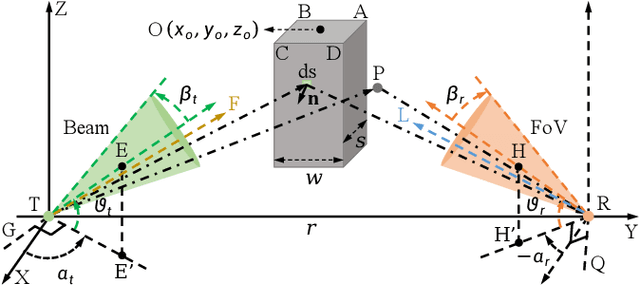
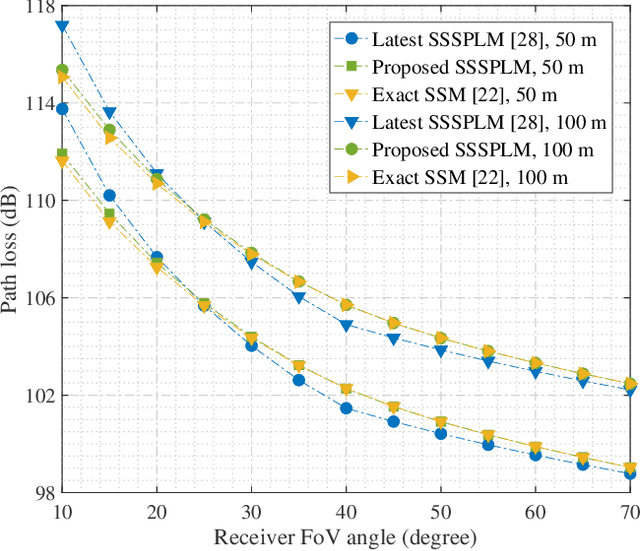
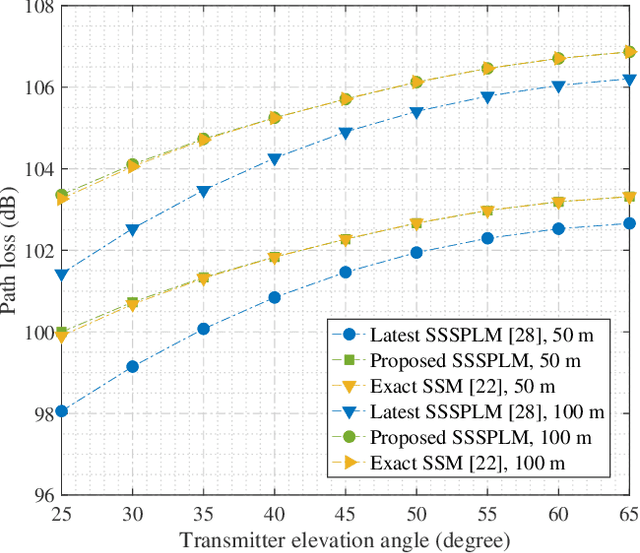
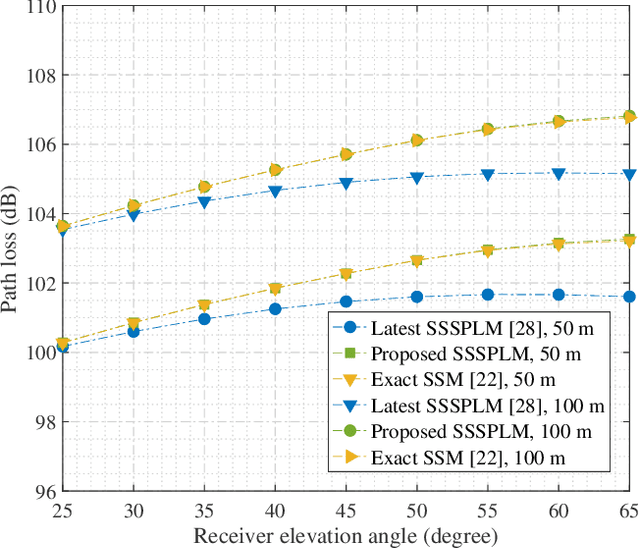
Abstract:As transceiver elevation angles increase from small to large, existing ultraviolet (UV) non-line-of-sight (NLoS) models encounter two challenges: i) cannot estimate the channel characteristics of UV NLoS communication scenarios when there exists an obstacle in the overlap volume between the transmitter beam and the receiver field-of-view (FoV), and ii) cannot evaluate the channel path loss for the wide beam and wide FoV scenarios with existing simplified single-scattering path loss models. To address these challenges, a UV NLoS scattering model incorporating an obstacle was investigated, where the obstacle's orientation angle, coordinates, and geometric dimensions were taken into account to approach actual application environments. Then, a UV NLoS reflection model was developed combined with specific geometric diagrams. Further, a simplified single-scattering path loss model was proposed with a closed-form expression. Finally, the proposed models were validated by comparing them with the Monte-Carlo photon-tracing model, the exact single-scattering model, and the latest simplified single-scattering model. Numerical results show that the path loss curves obtained by the proposed models agree well with those attained by related NLoS models under identical parameter settings, and avoiding obstacles is not always a good option for UV NLoS communications. Moreover, the accuracy of the proposed simplified model is superior to that of the existing simplified model for all kinds of transceiver FoV angles.
Channel Modeling for Ultraviolet Non-Line-of-Sight Communications Incorporating an Obstacle
Nov 08, 2024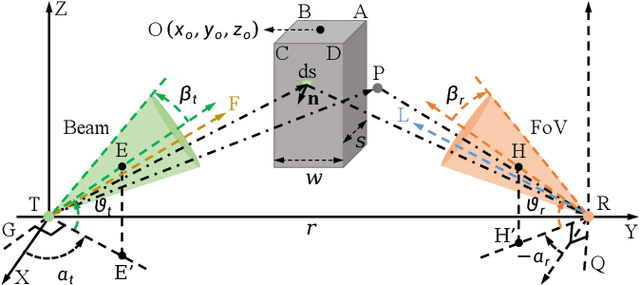
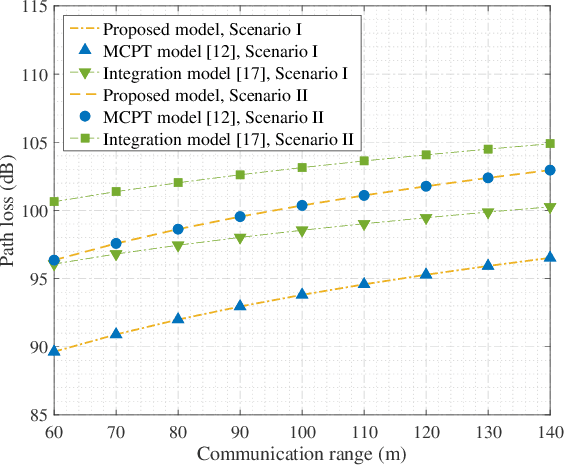
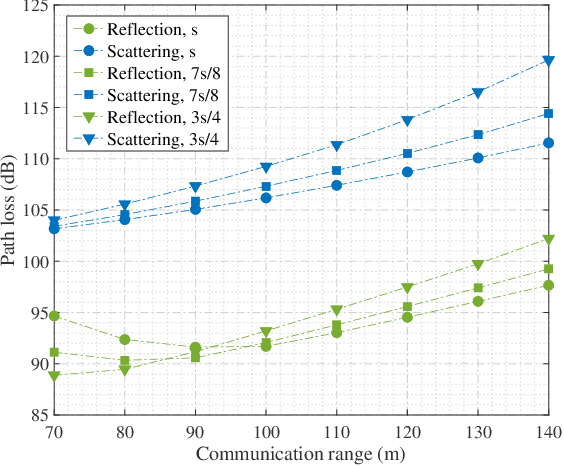
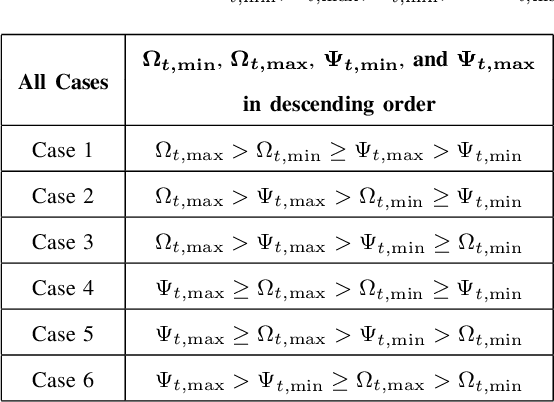
Abstract:Existing studies on ultraviolet (UV) non-line-of-sight (NLoS) channel modeling primarily focus on scenarios without any obstacle, which makes them unsuitable for small transceiver elevation angles in most cases. To address this issue, a UV NLoS channel model incorporating an obstacle was investigated in this paper, where the impacts of atmospheric scattering and obstacle reflection on UV signals were both taken into account. To validate the proposed model, we compared it to the related Monte-Carlo photon-tracing (MCPT) model that had been verified by outdoor experiments. Numerical results manifest that the path loss curves obtained by the proposed model agree well with those determined by the MCPT model, while its computation complexity is lower than that of the MCPT model. This work discloses that obstacle reflection can effectively reduce the channel path loss of UV NLoS communication systems.
Single-Collision Model for Non-Line-of-Sight UV Communication Channel With Obstacle
Nov 08, 2024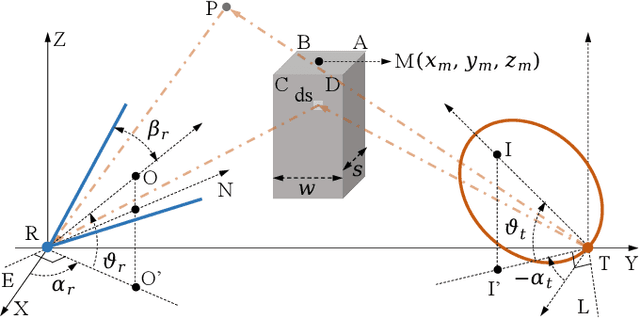
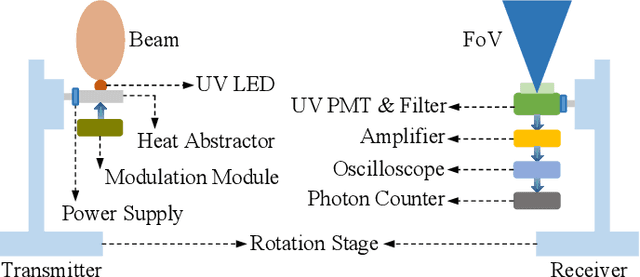
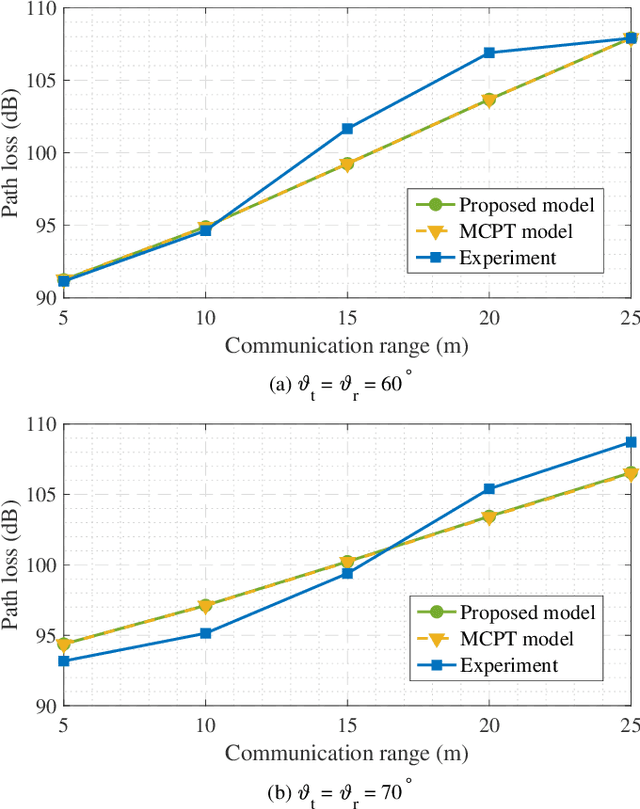
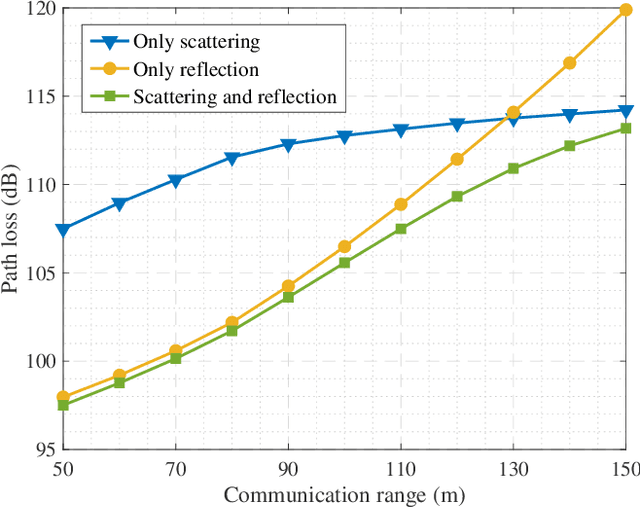
Abstract:Existing research on non-line-of-sight (NLoS) ultraviolet (UV) channel modeling mainly focuses on scenarios where the signal propagation process is not affected by any obstacle and the radiation intensity (RI) of the light source is uniformly distributed. To eliminate these restrictions, we propose a single-collision model for the NLoS UV channel incorporating a cuboid-shaped obstacle, where the RI of the UV light source is modeled as the Lambertian distribution. For easy interpretation, we categorize the intersection circumstances between the receiver field-of-view and the obstacle into six cases and provide derivations of the weighting factor for each case. To investigate the accuracy of the proposed model, we compare it with the associated Monte Carlo photon tracing model via simulations and experiments. Results verify the correctness of the proposed model. This work reveals that obstacle avoidance is not always beneficial for NLoS UV communications and provides guidelines for relevant system design.
Efficiently Training 7B LLM with 1 Million Sequence Length on 8 GPUs
Jul 16, 2024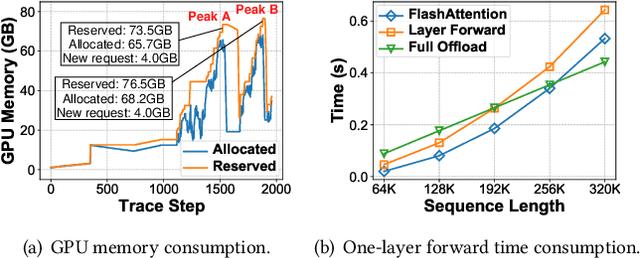
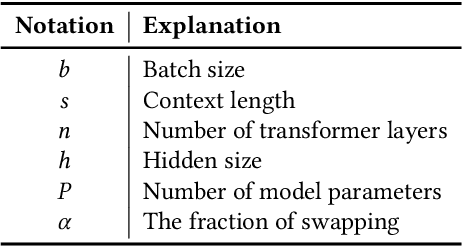
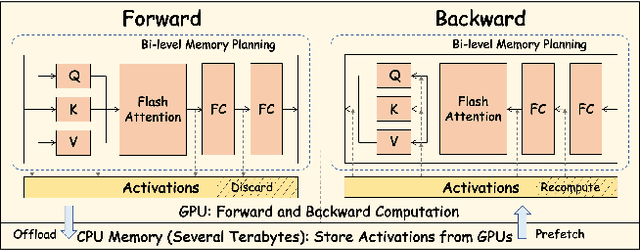
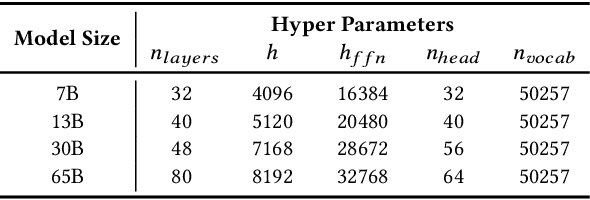
Abstract:Nowadays, Large Language Models (LLMs) have been trained using extended context lengths to foster more creative applications. However, long context training poses great challenges considering the constraint of GPU memory. It not only leads to substantial activation memory consumption during training, but also incurs considerable memory fragmentation. To facilitate long context training, existing frameworks have adopted strategies such as recomputation and various forms of parallelisms. Nevertheless, these techniques rely on redundant computation or extensive communication, resulting in low Model FLOPS Utilization (MFU). In this paper, we propose MEMO, a novel LLM training framework designed for fine-grained activation memory management. Given the quadratic scaling of computation and linear scaling of memory with sequence lengths when using FlashAttention, we offload memory-consuming activations to CPU memory after each layer's forward pass and fetch them during the backward pass. To maximize the swapping of activations without hindering computation, and to avoid exhausting limited CPU memory, we implement a token-wise activation recomputation and swapping mechanism. Furthermore, we tackle the memory fragmentation issue by employing a bi-level Mixed Integer Programming (MIP) approach, optimizing the reuse of memory across transformer layers. Empirical results demonstrate that MEMO achieves an average of 2.42x and 2.26x MFU compared to Megatron-LM and DeepSpeed, respectively. This improvement is attributed to MEMO's ability to minimize memory fragmentation, reduce recomputation and intensive communication, and circumvent the delays associated with the memory reorganization process due to fragmentation. By leveraging fine-grained activation memory management, MEMO facilitates efficient training of 7B LLM with 1 million sequence length on just 8 A800 GPUs, achieving an MFU of 52.30%.
Optical IRS for Visible Light Communication: Modeling, Design, and Open Issues
May 29, 2024Abstract:Optical intelligent reflecting surface (OIRS) offers a new and effective approach to resolving the line-of-sight blockage issue in visible light communication (VLC) by enabling redirection of light to bypass obstacles, thereby dramatically enhancing indoor VLC coverage and reliability. This article provides a comprehensive overview of OIRS for VLC, including channel modeling, design techniques, and open issues. First, we present the characteristics of OIRS-reflected channels and introduce two practical models, namely, optics model and association model, which are then compared in terms of applicable conditions, configuration methods, and channel parameters. Next, under the more practically appealing association model, we discuss the main design techniques for OIRS-aided VLC systems, including beam alignment, channel estimation, and OIRS reflection optimization. Finally, open issues are identified to stimulate future research in this area.
Channel Estimation for Optical Intelligent Reflecting Surface-Assisted VLC System: A Joint Space-Time Sampling Approach
Apr 23, 2024Abstract:Optical intelligent reflecting surface (OIRS) has attracted increasing attention due to its capability of overcoming signal blockages in visible light communication (VLC), an emerging technology for the next-generation advanced transceivers. However, current works on OIRS predominantly assume known channel state information (CSI), which is essential to practical OIRS configuration. To bridge such a gap, this paper proposes a new and customized channel estimation protocol for OIRSs under the alignment-based channel model. Specifically, we first unveil OIRS spatial and temporal coherence characteristics and derive the coherence distance and the coherence time in closed form. Next, to achieve fast beam alignment over different coherence time, we propose to dynamically tune the rotational angles of the OIRS reflecting elements following a geometric optics-based non-uniform codebook. Given the above beam alignment, we propose an efficient joint space-time sampling-based algorithm to estimate the OIRS channel. In particular, we divide the OIRS into multiple subarrays based on the coherence distance and sequentially estimate their associated CSI, followed by a spacetime interpolation to retrieve full CSI for other non-aligned transceiver antennas. Numerical results validate our theoretical analyses and demonstrate the efficacy of our proposed OIRS channel estimation scheme as compared to other benchmark schemes.
Channel Estimation for Optical IRS-Assisted VLC System via Spatial Coherence
Apr 23, 2024Abstract:Optical intelligent reflecting surface (OIRS) has been considered a promising technology for visible light communication (VLC) by constructing visual line-of-sight propagation paths to address the signal blockage issue. However, the existing works on OIRSs are mostly based on perfect channel state information (CSI), whose acquisition appears to be challenging due to the passive nature of the OIRS. To tackle this challenge, this paper proposes a customized channel estimation algorithm for OIRSs. Specifically, we first unveil the OIRS spatial coherence characteristics and derive the coherence distance in closed form. Based on this property, a spatial sampling-based algorithm is proposed to estimate the OIRS-reflected channel, by dividing the OIRS into multiple subarrays based on the coherence distance and sequentially estimating their associated CSI, followed by an interpolation to retrieve the full CSI. Simulation results validate the derived OIRS spatial coherence and demonstrate the efficacy of the proposed OIRS channel estimation algorithm.
Free Space Optical Integrated Sensing and Communication Based on DCO-OFDM: Performance Metrics and Resource Allocation
Dec 21, 2023Abstract:As one of the six usage scenarios of the sixth generation (6G) mobile communication system, integrated sensing and communication (ISAC) has garnered considerable attention, and numerous studies have been conducted on radio-frequency (RF)-ISAC. Benefitting from the communication and sensing capabilities of an optical system, free space optical (FSO)-ISAC becomes a potential complement to RF-ISAC. In this paper, a direct-current-biased optical orthogonal frequency division multiplexing (DCO-OFDM) scheme is proposed for FSO-ISAC. To derive the spectral efficiency for communication and the Fisher information for sensing as performance metrics, we model the clipping noise of DCO-OFDM as additive colored Gaussian noise to obtain the expression of the signal-to-noise ratio. Based on the derived performance metrics, joint power allocation problems are formulated for both communication-centric and sensing-centric scenarios. In addition, the non-convex joint optimization problems are decomposed into sub-problems for DC bias and subcarriers, which can be solved by block coordinate descent algorithms. Furthermore, numerical simulations demonstrate the proposed algorithms and reveal the trade-off between communication and sensing functionalities of the OFDM-based FSO-ISAC system.
Optical Integrated Sensing and Communication: Architectures, Potentials and Challenges
Dec 21, 2023



Abstract:Integrated sensing and communication (ISAC) is viewed as a crucial component of future mobile networks and has gained much interest in both academia and industry. Similar to the emergence of radio-frequency (RF) ISAC, the integration of free space optical communication and optical sensing yields optical ISAC (O-ISAC), which is regarded as a powerful complement to its RF counterpart. In this article, we first introduce the generalized system structure of O-ISAC, and then elaborate on three advantages of O-ISAC, i.e., increasing communication rate, enhancing sensing precision, and reducing interference. Next, waveform design and resource allocation of O-ISAC are discussed based on pulse waveform, constant-modulus waveform, and multi-carrier waveform. Furthermore, we put forward future trends and challenges of O-ISAC, which are expected to provide some valuable directions for future research.
 Add to Chrome
Add to Chrome Add to Firefox
Add to Firefox Add to Edge
Add to Edge